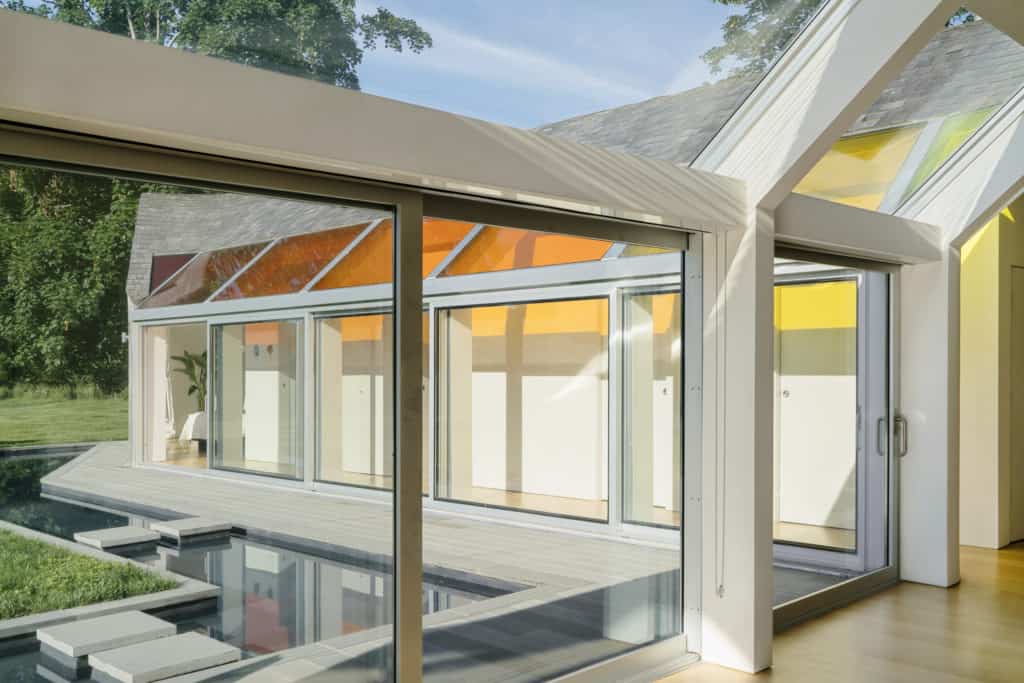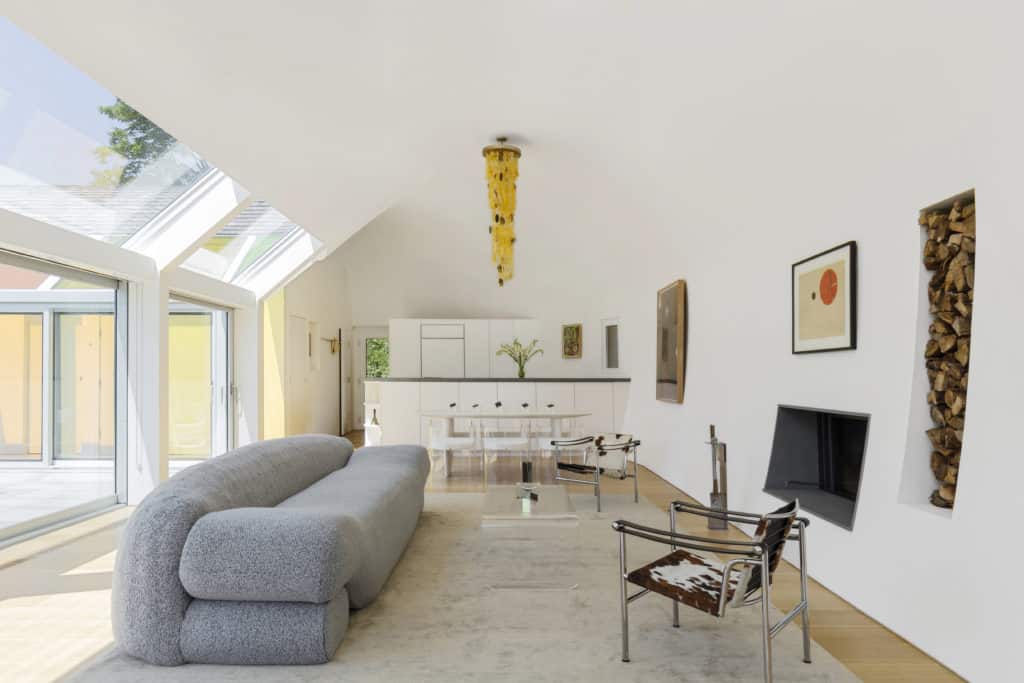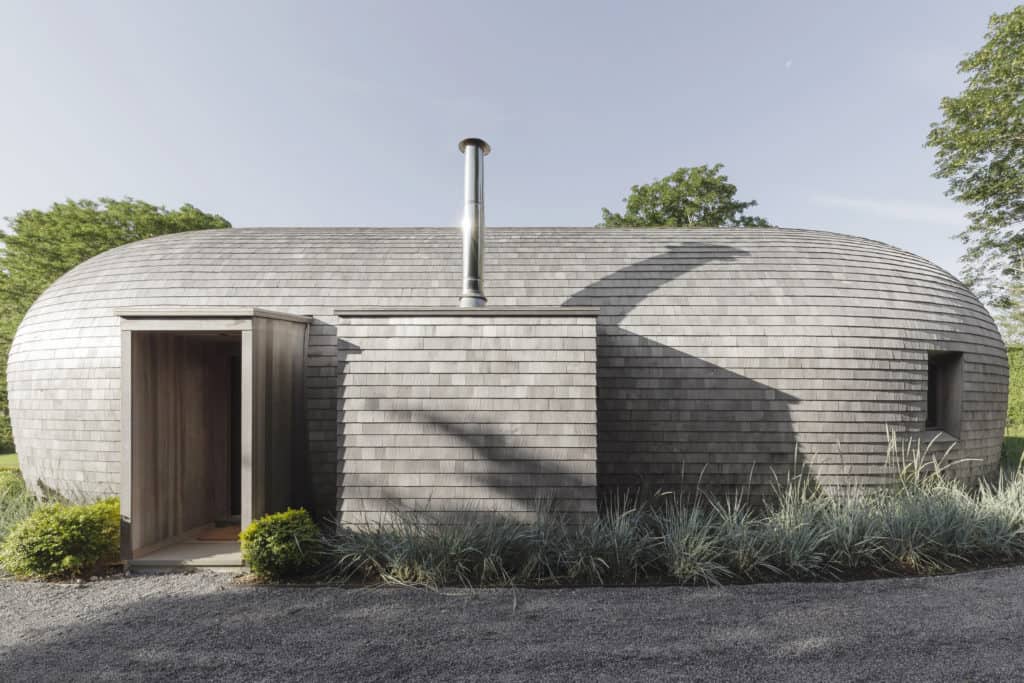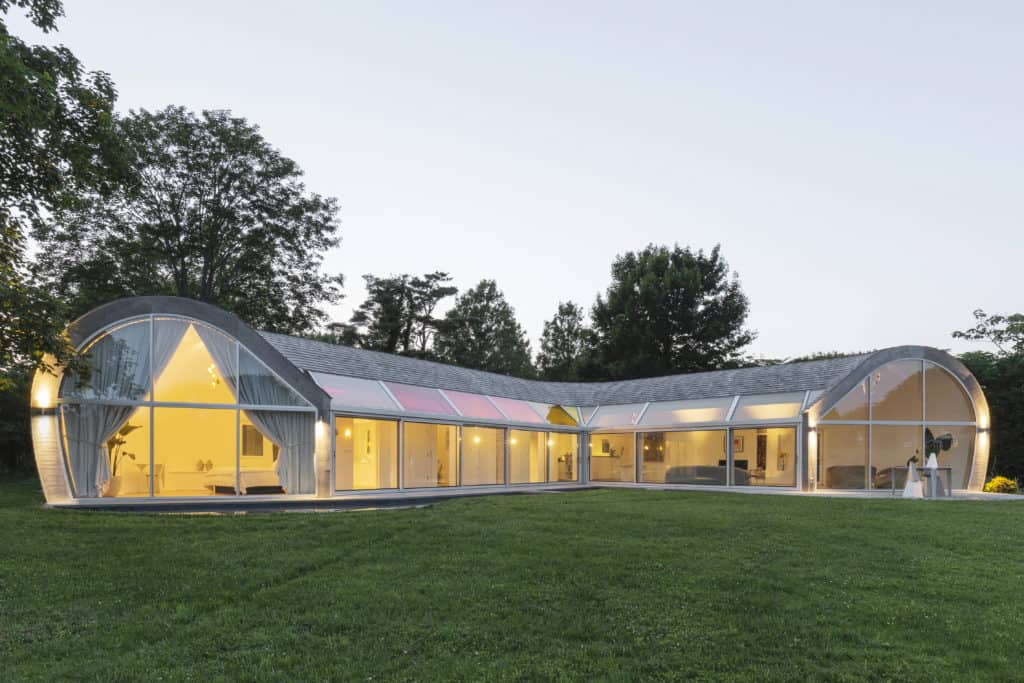It’s fun to imagine what the gilded age architect Stanford White would have made of Cocoon House, the architect Nina Edwards Anker’s sustainable masterpiece in Southampton, New York. It so happens that Cocoon House shares a plot of land with a shingled cottage which White conceived as a carriage house in 1890. (Both houses are part of a family compound.) Geographic proximity notwithstanding, the two structures couldn’t be more different. The first is the product of conventional building methods and design; the second, with its rounded walls, colored skylights, narrow reflecting pool that doubles as a rainwater-collecting cistern, and passive house-certified windows and doors, is a bold experiment in glass and light. Sui generis, the LEED-certified house stands in particularly stark contrast to the shingle-style architecture that has been emblematic of Hamptons style at least since Stanford White’s day.

But Anker, who is the founder of nea studio and an evangelist for environmentally sound design practices, predicts that we will soon witness a sea change, with more LEED-certified houses on the horizon. Certainly, her own work represents a paradigm shift: a modern beach house of modest proportions that’s comfortable, snug, and dry. The south and east elevations feature dazzling walls of glass — sliding doors, to be precise — and “natural” cooling and heating systems, thanks to the wind that blows in off the ocean and the warmth of the sun in addition to thick closed-cell foam insulation in the north and west walls. She says that in the winter, the ambient temperature in the house is so comfortable that she and her husband and two sons rarely need to bundle up. “We were lucky that the house’s two main views were on the south side so we were able to make passive principals work for us,” says Anker, noting that passive houses often suffer from small windows and/or insufficient natural light.
The desire to paint with light was but one of the project’s many motive forces. During the day, the triangular skylight in the master bedroom acts as a sundial, silently announcing the time by the quality of the light. She explains how light streams in through the top of the windows and projects sunbeams on to the curved back wall, which “abstracts whatever shapes are coming in through the skylights and reflecting pool.” And then there are what Anker describes as “very soothing water reflections,” also on the back wall, from the cistern.
At night, chandeliers strung with seashells and photovoltaic panels — which Anker also designed — illuminate the central living areas. “It’s extremely sensuous,” she says. “The solar chandeliers glow and you see the stars, and if you open the sliding doors, you smell the garden, which is filled with native plants — beach grasses and wisteria — and the ocean breeze. And the sounds are amazing! The round shape mellows the acoustics beautifully, blurring the boundary between inside and outside.”
Anker, whose nearest neighbors are her brother and his wife, says that consumer reaction to the house has been surprisingly positive. “My brother is a banker and at first I was afraid that some of his more conservative friends wouldn’t like it. But that wasn’t the case. Plus, because the house is so small and the surrounding landscape is so big, it looks like a folly in the garden.”












![Dive into a week-long celebration of exquisite dining experiences with Long Island Restaurant Week! From gourmet feasts to hidden gems, this is your passport to a world of flavors. The culinary adventure lasts now through Sunday, February 4th. [link in bio]](https://hamptonsrealestateshowcase.com/wp-content/uploads/sb-instagram-feed-images/424429319_323460817321735_5618008070091767644_nfull.jpg)
![Set to be one of the tallest buildings in Sunny Isles and within very close proximity to Miami Beach, Bal Harbour Shops, and the Miami Design District, the @srresidencessib has been crafted to evoke a feeling of harmony with the majesty of nature in its purest forms. Each home—remarkable in its volume and scale— represents the next in modern luxury with expansive layouts, breathtaking proportions of master bedroom suites, and the exquisite selection of the finest materials and finishes. [link in bio]](https://hamptonsrealestateshowcase.com/wp-content/uploads/sb-instagram-feed-images/422750601_949143036552944_6719399525785290858_nfull.jpg)
![@tataharperskincare is a brand of natural skincare products that are designed to deliver real results without the use of synthetic chemicals. The company was founded by Tata Harper, a pioneer in natural luxury skincare who couldn't find 100% natural products that met her standards of efficacy, quality, and purity. You can shop all treatments and oils at @tenetshop in Southampton! [link in bio]](https://hamptonsrealestateshowcase.com/wp-content/uploads/sb-instagram-feed-images/423414770_969842424507079_5853121257190937345_nfull.jpg)
![Located south of the highway in Water Mill, our home of the week is a 10,400± sq. ft. new construction estate set on nearly 1± acre with a detached 3-car garage, a pool cabana, and a heated gunite pool and spa. Indulge in the ultimate luxury lifestyle at 91 Swans Neck Lane, where leisure and entertainment meet seclusion and serenity. Represented by @bespoke.realestate. [link in bio]](https://hamptonsrealestateshowcase.com/wp-content/uploads/sb-instagram-feed-images/422870950_1041350420315152_3955490862347124304_nfull.jpg)
![After a very exciting bidding war, La Dune has sold at the @sothebys "Visions of America" auction for $88.5M! The property, once the most expensive listing the Hamptons and famed for an appearance in the Woody Allen film “Interiors,” had been on and off the market since 2016. It was most recently listed in 2022 at $150M. [link in bio]](https://hamptonsrealestateshowcase.com/wp-content/uploads/sb-instagram-feed-images/421035980_764229365568560_2560982266395777347_nfull.jpg)
![From timeless totes to sleek carry-ons, @parkerclay has your travel game covered ✈️👜 Traveling isn't just a journey; it's a statement. Explore the world with elegance and purpose because when your luggage looks this good, the adventure is even sweeter! [link in bio]](https://hamptonsrealestateshowcase.com/wp-content/uploads/sb-instagram-feed-images/420894716_2620139351479777_3651823090083239840_nfull.jpg)
![Bidding for "La Dune" in Southampton is currently underway as part of @sothebys “Visions of America” sale! The iconic compound is complete with two residences, over 400± ft. of bulkhead beachfront, palatial grounds, two heated pools, a tennis court and direct access to the ocean beach. Bidding closes tomorrow, January 24th at 4pm. [link in bio]](https://hamptonsrealestateshowcase.com/wp-content/uploads/sb-instagram-feed-images/421054625_1114416103054206_3172925505713582920_nfull.jpg)

